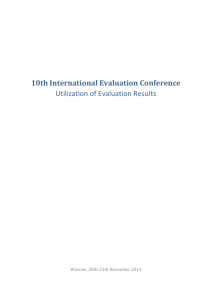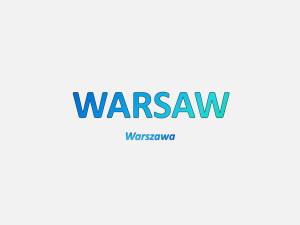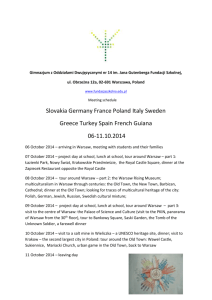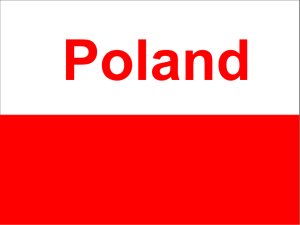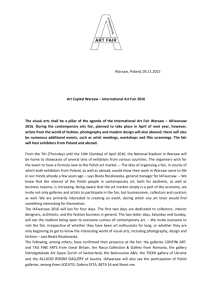Analysis of the strategic groups maps of the higher schools sector in
advertisement
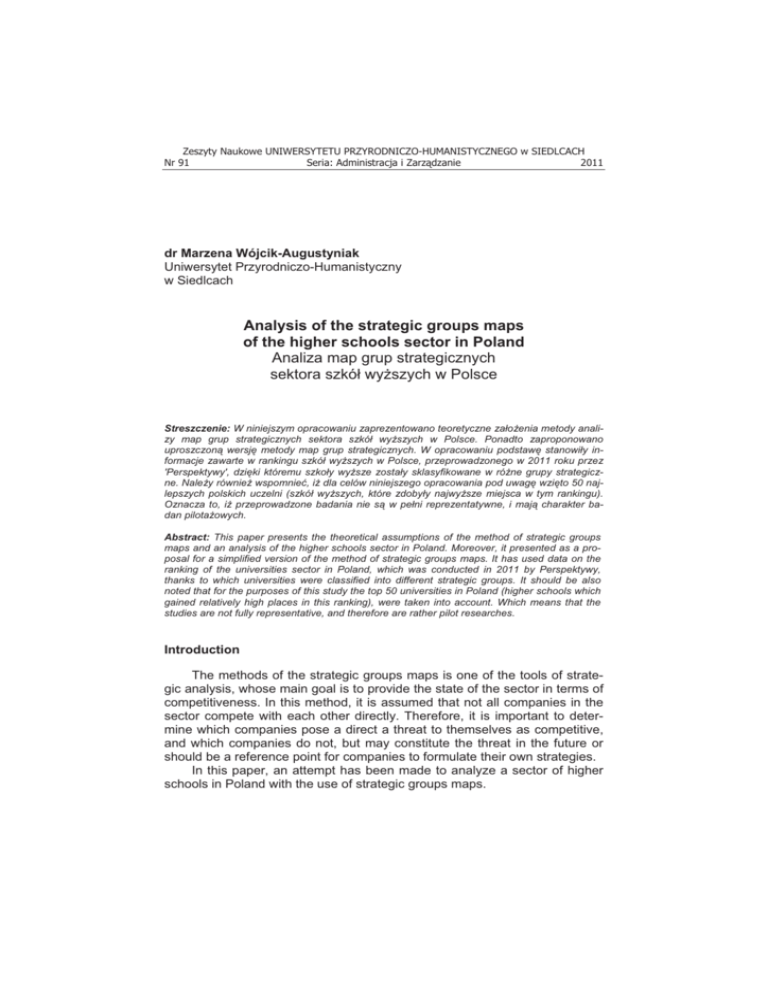
Zeszyty Naukowe UNIWERSYTETU PRZYRODNICZO-HUMANISTYCZNEGO w SIEDLCACH Nr 91 Seria: Administracja i Zarz dzanie 2011 dr Marzena Wójcik-Augustyniak Uniwersytet Przyrodniczo-Humanistyczny w Siedlcach Analysis of the strategic groups maps of the higher schools sector in Poland Analiza map grup strategicznych sektora szkó wy!szych w Polsce Streszczenie: W niniejszym opracowaniu zaprezentowano teoretyczne za o!enia metody analizy map grup strategicznych sektora szkó wy!szych w Polsce. Ponadto zaproponowano uproszczon" wersj# metody map grup strategicznych. W opracowaniu podstaw# stanowi y informacje zawarte w rankingu szkó wy!szych w Polsce, przeprowadzonego w 2011 roku przez 'Perspektywy', dzi#ki któremu szko y wy!sze zosta y sklasyfikowane w ró!ne grupy strategiczne. Nale!y równie! wspomnie$, i! dla celów niniejszego opracowania pod uwag# wzi#to 50 najlepszych polskich uczelni (szkó wy!szych, które zdoby y najwy!sze miejsca w tym rankingu). Oznacza to, i! przeprowadzone badania nie s" w pe ni reprezentatywne, i maj" charakter badan pilota!owych. Abstract: This paper presents the theoretical assumptions of the method of strategic groups maps and an analysis of the higher schools sector in Poland. Moreover, it presented as a proposal for a simplified version of the method of strategic groups maps. It has used data on the ranking of the universities sector in Poland, which was conducted in 2011 by Perspektywy, thanks to which universities were classified into different strategic groups. It should be also noted that for the purposes of this study the top 50 universities in Poland (higher schools which gained relatively high places in this ranking), were taken into account. Which means that the studies are not fully representative, and therefore are rather pilot researches. Introduction The methods of the strategic groups maps is one of the tools of strategic analysis, whose main goal is to provide the state of the sector in terms of competitiveness. In this method, it is assumed that not all companies in the sector compete with each other directly. Therefore, it is important to determine which companies pose a direct a threat to themselves as competitive, and which companies do not, but may constitute the threat in the future or should be a reference point for companies to formulate their own strategies. In this paper, an attempt has been made to analyze a sector of higher schools in Poland with the use of strategic groups maps. 116 M. Wójcik-Augustyniak Strategic groups maps as a tool of strategic analysis Strategic analysis is one of the key steps in the process of strategic management, Its quality has a significant influence on the other activities of the organization, from strategy formulation to the effects of control. Therefore it should be treated in a particular way, which manifests, inter alia, in the choice of methods by which organizations will be collecting and processing information. Strategic analysis is carried out on three levels of organization environment: global, competitive and internal. This study focuses on the analysis of the competitive environment, using one of the methods, which is the analysis of strategic groups maps. This method, developed in 1977 by M.E. Porter and R.E. Caves, based on the concept of M.S. Hunt and H.H. Newman's independently working on this topic, is a useful way of graphic presentation of the competition in the sector and checking, how occurring changes and trends could affect it. They reflect the 'strategic space'1. The essence of the strategic groups maps analysis is to identify the proper balance of power within the sector. It overlooks the fact from the assumption that in the sector all companies not always compete with each other, but form so-called strategic groups within where firms have a competitive struggle in a similar way2. The task of analysis is to determine whether in a given sector, strategic groups exist, if so, how many, and in which of them the company, for which the analysis is carried out, operates. Enterprises in the sector can be grouped with the common characteristics that constitute a kind of identifier of sources of competitive position in the sector and are determinants of income generation. They are termed the dimensions of competitive strategy, and these are3: • specialization expressed by the degree of a company's activities focus on a specific market segment, • company brand identity, which for many companies is more important than price competitiveness, eg, • selection of distribution channels, that is the choice of ways of selling through specialty shops or multi-point customer service • product quality, • technological leadership, which does not necessarily mean a production of high quality, • the way of enterprise organizing in manufacturing processes (vertical and horizontal integration), 1 Porter M.E., 1992: Strategia konkurencji. Metody analizy sektorów i konkurentów, PWE, Warszawa, p. 161. Gierszewska G., Romanowska M., 2007: Analiza strategiczna przedsi#biorstwa, PWE, Warszawa, p. 128; Rokita J., 2005: Zarz"dzanie strategiczne. Tworzenie i utrzymywanie przewagi konkurencyjnej, PWE, Warszawa, pp. 63-64. 3 Gierszewska G., 2004: Strategie przedsi#biorstw w dobie globalizacji, WSHiP, Warszawa, pp. 110-111. 2 Seria: Administracja i Zarz dzanie (18)2011 ZN nr 91 Analysis of the strategic groups maps of the higher schools sector in Poland 117 cost position, service, for example, individual service in a customer's home, engineering assistance, technical advice, • pricing policy, which depends on the item cost and product quality, but price is an independent factor in the creation of corporate strategy, • product availability in terms of the distribution network and trade offer (discounts, hire-purchase), • relationships between the parent company and a company that may be part of a conglomerate, a holding company, a multinational corporation, these relations govern decision-making processes and ways of formulating the strategy, financial resources held by the company, some activities and functions, • relationships between the national or local government, which holds in the case of international companies. After preparing strategic group maps of the sector several analytical operations can be carried out4: Identification of mobility barriers, protecting the group against attacks from other groups. Identification of groups with insignificant or marginal importance, which are candidates who exit or try to move to another group. Plotting the directions of movements of companies' strategies, in which they can be moved from the point of view of the sector as a whole. Analysis of trends in the sector for the strategic group map. Predicting the response of the sector to an event. • • Characteristics of higher education sector in Poland The chain of higher schools in Poland is sufficient, and even overdeveloped. There is the effect of 'institutional fragmentation' which means that access to education is easy without having to change ones the place of living5. In the 1990’s there was a disproportion difference between the number of people seeking to education and the possibility of achieving this aim in state universities. The basis for change was the Law on Higher Education of 12 September 1990, thanks to which it became possible to establish nonstate universities. Therefore, the dynamic development of private universities has led to a so-called educational boom. In the academic year 1991/1992 10 non-state universities functioned, at which 13 610 students studied. Over 4 Porter M.E., 1992: Strategia konkurencji. Metody analizy sektorów i konkurentów, PWE, Warszawa, p. 163. 5 Wo"nicki J., 2007: Uczelnie Akademickie jako instytucje !ycia publicznego, Wyd. Fundacja Rektorów Polskich, Warszawa, p. 98; Szarota Z., Litawa A., 2009: Jako%$ kszta cenia w ocenie studentów szkó publicznych i niepublicznych – próba porównania stanowisk, in ‘Edukacja Doros ych’, 1 (60), p. 91. ZN nr 91 Seria: Administracja i Zarz dzanie (18)2011 118 M. Wójcik-Augustyniak the years the dynamic development of private universities was observed, and in the 2009/2010 academic year 330 non-state universities in 62 cities are functioning, with nearly 2 million students in total6. Financial management, which is carried by the universities, is based, in particular, on subsidies from the state budget (70% of the universities funding sources), and from external means, obtained mostly from the European Union. As part of the operational programmes for 2007-2013, Innovative Economy, Human Capital, Infrastructure and Environment, Ministry of Science and Higher Education has received amount of 4.1 billion euros which is to be earmarked for expansion and modernization of higher education in Poland. Moreover, receiving grants, from cooperation with business and universities own revenues, which include: payment for studies (full-time study at public universities is free, while other forms and studies at non-public higher schools are payable), editing indexes, library cards and ID cards7. Higher schools, offering educational services and conducting research, must have the necessary resources and effectively manage them. Resources can be divided into measurable, which could include the number of students, staff numbers, infrastructure, equipment and finances, as well as intangible resources, which include individual and organizational competencies, and relationships. Among individual competencies skills, knowledge and attitudes of academic staff can be distinguished, and organizational competencies include information system, including library collections, student administrative services. Relationships include internal relations between the university authorities, academics and university administration and external relations, mainly with students and alumni, as well as with other universities, contractors and the local community8. Taking into consideration data contained in Table 1. it can be concluded that in 2005 compared to 2000, an increase in number of higher schools by 43.5%. In subsequent years there has any been not more significant increase in the number of universities in Poland. This is due to saturation of the market of education services of higher schools and since 2005, followed by a gradual decrease in the number of students9. In the year 2009/2010 in Poland, 461 higher schools functioned, including 131 public, in which 1 266.9 thousand. people studied (66.7% of all students)10. 6 Antosz A., 2009: Uczestnictwo doros ych Polaków w edukacji w okresie … in ‘Edukacja doros ych’, 1 (60), p. 29. 7 www.profuturo.agh.edu.pl/pliki/Referaty_IV_KKMU/NE/SLABONSKA_TERESA.pdf. 8 Zieli#ski W., 2005: Co hamuje rozwój e-nauczania w Polsce, in J. Mischke (Ed.), Akademia on-line, Wyd. WSzH-E, $ód", p. 68. 9 www.stat.gov.pl/cps/rde/xbcr/gus/PUBL_e_not_nt_szkol_wyzszych_w_Polsce.pdf. 10 www.egospodarka.pl/58368,Szko y-wyzsze-w-Polsce,2,391.html Antosz A., 2009: Uczestnictwo doros ych Polaków w edukacji w okresie … in ‘Edukacja doros ych’, 1 (60), p. 29. Seria: Administracja i Zarz dzanie (18)2011 ZN nr 91 Analysis of the strategic groups maps of the higher schools sector in Poland 119 Table 1. The number of higher schools and students in Poland in 2000, 2005, and 2007-2010 Specification / Year Number of higher schools Number of students including foreign students (in thous.) 2000 310 2005 445 2007 455 2008 456 2009 461 2010 467 1584,8 1953,8 1937,4 1927,8 1900,0 - Source: www.stat.gov.pl/cps/rde/xbcr/gus/PUBL_e_not_nt_szkol_wyzszych_w_Polsce.pdf. Full-time studies were the dominant form of study at public universities, while at non-public higher schools - part-time studies. In the 2009/2010 academic year, most people were educated in the fields of economic and administration, social and pedagogical (these were also the most popular fields in 2000), while in 1990 most people were educated in technical fields related to business and management, and pedagogical11. The biggest academic centre in Poland is the largest higher school University of Warsaw, having 55.4 thousand. students. Outside Warsaw, the largest academic centres are Kraków, Wroc aw, Pozna#, $ód", Lublin, Gda#sk and Katowice12. Criteria of strategies differentiation in the higher schools sector In order to proper construction of strategic groups maps it is important to define precisely the criteria for differentiating business strategy for the sector. Examples of criteria may be: product quality, technologies used, specializing in product supply, price or production costs. Of course, each sector has different criteria so a separate list of them should be made, while criteria are the key success factors of enterprises operating in the sector. Developing them allows to create multiple maps of strategic groups, which in turn allows more accurate determination in which strategic group (or rather groups), the company, from the viewpoint of which the analysis is carried out, operates. An equally important element of the procedure for the analysis of strategic groups maps is developing the characteristics. A criteria of differentiation strategy in the sector of higher education can be developed, taking into consideration criteria from various rankings, for evaluating the university. Taking into account the international rankings, in which the most important factor is the scientific strength of the universities (Shanghai ranking), might obscure the picture with regard to Polish universities, of which only two (Warsaw University and Jagiellonian University) are in the charts, and in addition to fairly remote locations (four hundred). Of course, worldwide rankings are for universities, including Polish ones, a kind of banchmark. Nevertheless, it is unlikely that any Polish university will be able to find itself high on such rankings. On the other hand, do 11 12 www.stat.gov.pl/cps/rde/xbcr/gus/PUBL_e_not_nt_szkol_wyzszych_w_Polsce.pdf. www.egospodarka.pl/58368,Szko y-wyzsze-w-Polsce,2,391.html. ZN nr 91 Seria: Administracja i Zarz dzanie (18)2011 120 M. Wójcik-Augustyniak higher schools in Poland really actually need, at any price to move up the rankings to the more significant positions. With the current method of financing schools it is not feasible. Therefore, it is more appropriate to take into account the determinants, which are more congruent to Polish reality: the European and Polish rankings, built for the purpose of taking into account the circumstances of the Polish sector of higher education. In this paper the basis for the analysis were the results of the ranking of universities in Poland in 2011, conducted by ‘Perspektywy’13. Fifty out of the top four hundred and sixty seven universities operating in Poland were presented. So this is not a full picture of the sector, but nevertheless allows to draw conclusions from the perspective of higher schools, those which found themselves in the statement and those excluded. The criteria for differentiating strategies of universities in Poland were adopted from the previously mentioned ranking Perspektywy. These criteria are: scientific efficiency, academic prestige, internationalization, scientific potential, study conditions and innovation14. Scientific efficiency is described by such metrics as: own staff development, conferred academic degrees, the efficiency of obtaining external funding for research, publications, citations, H-index, the share of universities in the 7th EU Framework Programme, doctoral studies. Academic prestige is measured by: the preferences of employers, assessment by the academic staff, international recognition, the choice of Olympic athletes. The level of internationalization of education is measured through: study programmes conducted in foreign languages, studying in foreign languages, students’ exchange (outcoming and incoming), foreign students, academics from abroad, lectures in foreign languages. Another criterion, which is the scientific potential is described by such metrics as: parametric evaluation, the right to confer academic degrees, saturation of staff with the highest qualifications, accreditations. Criterion of study conditions includes: availability of highly qualified staff for students, printed collections, electronic sets, conditions for using the library, availability for out-of-town students, sporting achievements. Innovation is measured by a number of patents, protective rights, licenses, funds obtained from the EU, as well as innovative university facilities. Market share, which is a necessary measure in preparing strategic groups maps, in relation to higher education can be measured by the number of students at the university. It should be mentioned that what determined the criteria and characteristics ought to be measurable. For the purposes of this paper, according to the ranking by ‘Perspektywy’, the following numerical ranges can be assumed under 35 - the low level, 36-64 medium level, above 65 - a high level. 13 14 www.perspektywy.pl/index.php?option=com_content&task=blogcategory&id=318&Itemid=832. Ibidem. Seria: Administracja i Zarz dzanie (18)2011 ZN nr 91 Analysis of the strategic groups maps of the higher schools sector in Poland 121 It should also be taken into account the weight of each criteria: scientific efficiency (30%), academic prestige (25%), internationalization (15%), scientific potential (15%), study conditions (10%), innovation (5%). It should be noted that the criteria of ranking are the synthetic evaluation, taking into consideration the elements contained in the group. By creating a map of strategic groups the various criteria of the group can also be taken into account. In this case, each criterion should specify different levels of features. Also important is the question of the allocation of higher education for particular groups of fields: economics, humanities, medical sciences, agriculture and forestry, social sciences, technical and computer science. Higher schools can be divided due to their type: technical colleges, universities, agricultural, medical schools, business schools, teacher education, physical education academy. Examples of strategic groups maps for the higher schools sector in Poland Taking into account data on locations of individual universities in the ranking list summary of 50 universities was created in terms of pairs of criteria by which it was possible to develop maps of strategic groups. In order to simplify the mapping of strategic groups in the higher education sector in Poland, they have been divided into nine basic groups. (Figure 1.) Each of the top 50 higher schools was classified into one group mentioned in Table 2. This is obviously too simplistic, but this approach to strategic groups maps more clearly illustrates the division in the sector of higher schools in Poland, as single strategic groups. Criterion Table 2. A simplified version of strategic groups map 65-100 36-64 0-35 high-low medium-low low-low 0-35 high-medium medium-medium low-medium 36-64 Criterion high-high medium-high low-high 65-100 Source: own researches. Figure 2. presents, in synthetic form, individual strategic groups of universities in terms of criteria: scientific efficiency and academic prestige. Based on data contained in table 3 it can be concluded that the largest number of universities, is the group characterized by a medium level of scientific efficiency and low level of academic prestige. These are in most cases, relatively large universities (with a large number of students), so it can be concluded that the market share of this group is the largest. It should also be noted that in the group of the universities, giving the highest levels of both criterion are the largest and the most prestigious Polish universities: Jagiellonian University, the University of Warsaw and Warsaw University of Technology. ZN nr 91 Seria: Administracja i Zarz dzanie (18)2011 122 M. Wójcik-Augustyniak 36-64 Scientific efficiency 65*100 Table 3. Strategic groups of the top 50 higher schools in Poland according to the criteria: scientific efficiency and academic prestige 0-35 Medical University of Bialystok Medical University of Lublin Uniwersytet Medyczny im. Karola Marcinkowskiego w Poznaniu Medical University of Warsaw Medical University of Silesia Nicolaus Copernicus University Pomeranian Medical University Akademia Obrony Narodowej w Warszawie Medical University of Gda#sk Warsaw University of Life Sciences The John Paul II Catholic University of Lublin Military University of Technology Medical University of Lodz Gda#sk University of Technology University of Silesia in Katowice University of Gda#sk Wroclaw Medical University Poznan University of Technology Technical University of Lodz Pedagogical University of Cracow Wroc aw University of Enironmental and Life Sciences University of Lodz Poznan University of Economics The Pontifical University of John Paul II in Cracow Maria Curie-Sk odowska University University of Agriculture in Krakow Silesian University of Technology Collegium Civitas Cardinal Stefan Wyszy#ski University Czestochowa University of Technology University of Life Sciences in Lublin Kielce University of Technology Wroclaw University of Economics West Pomeranian University of Technology Szczecin Pozna# University of Life Sciences University of Bialystok University of Warmia and Mazury in Olsztyn Polish-Japanese Institute of Information Technology The University School of Psychical Education in Krakow Opole University Lublin University of Technology Józef Pi sudski University of Physical Education in Warsaw The Jan Kochanowski University of Humanities and Sciences in Kielce Adam Mickiewicz University University of Wroc aw - - 0-35 36-64 65-100 AGH University of Science and Technology Wroc aw University of Technology Jagiellonian University in Krakow University of Warsaw Warsaw University of Technology - Academic prestige Source: own analysis on the basis of www.perspektywy.pl/index.php?option=com_content&task=blogcategory&id=318&Itemid=832 Table 4 presents a summary of universities including the criteria: internationalization and scientific potential. Seria: Administracja i Zarz dzanie (18)2011 ZN nr 91 Analysis of the strategic groups maps of the higher schools sector in Poland 123 Table 4. Strategic groups of the top 50 higher schools in Poland according to the criteria: internationalization and scientific potential Kozminski University University of Wroc aw 65*100 - Medical University of Warsaw Szczecin University Internationalization 36-64 Lazarski University Collegium Civitas 0-35 - 0-35 Medical University of Lublin Poznan University of Economics Pomeranian Medical University Warsaw University of Life Sciences Academy of Finance In Warsaw Cracow University of Economics Wroclaw Medical University University of Economics In Katowice Tadeusz Ko%ciuszko Cracow University of Technology Poznan University of Technology Opole University of Technology SWSPiZ Academy of Management Lodz Academy of International Studies University of Rzeszów Lublin University of Technology Warsaw School of Social Sciences and Humanities Medical University of Silesia The John Paul II Catholic University of Lublin Kazimierz Wielki University University of Bielsko-Biala Katowice School of Economics 36-64 Scientific potential University of Warsaw Jagiellonian University in Krakow Warsaw University of Technology Adam Mickiewicz University Technical University of Lodz Wroc aw University of Technology Warsaw School of Economics University of Wroc aw University of Lodz Poznan University of Medical Sciences AGH University of Science and Technology University of Warmia and Mazury in Olsztyn Gda#sk University of Technology University of Gda#sk Medical University of Gda#sk Wroclaw University of Economics Silesian University of Technology Nicolaus Copernicus University College of Marketing Management and Foreign Languages in Katowice Medical University of Lodz University of Silesia in Katowice Polish-Japanese Institute of Information Technology Józef Pi sudski University of Physical Education in Warsaw University School of Physical Education in Wroclaw 65-100 Source: own analysis on the basis of www.perspektywy.pl/index.php?option=com_content&task=blogcategory&id=318&Itemid=832. From table 4 it can be concluded that in terms of internationalization and scientific potential, the largest group of schools is the one with a low level of internationalization and a medium level of scientific potential. Once again it is noticeable that the University of Warsaw, Jagiellonian University in Krakow and Warsaw University of Technology are in one strategic group, except that, Adam Mickiewicz University, Technical University of Lodz and Wroclaw University of Technology joined that group. ZN nr 91 Seria: Administracja i Zarz dzanie (18)2011 124 M. Wójcik-Augustyniak A summary of strategic groups in terms of internationalization and academic prestige criteria is contained in table 5. 36-64 Internationalization 65*100 Table 5. Strategic groups of the top 50 higher schools in Poland acording to the criteria: internationalization and academic prestige 0-35 Medical University of Bialystok Medical University of Lublin Poznan University of Medical Sciences Medical University of Warsaw Medical University of Silesia Nicolaus Copernicus University Pomeranian Medical University National Defence University in Warsaw University of Wroc aw Medical University of Gda#sk Warsaw University of Life Sciences Adam Mickiewicz University AGH University Military University of Technology of Science Medical University of Lodz and Technology Gda#sk University of Technology Wroc aw University University of Silesia in Katowice of Technology University of Gda#sk Wroclaw Medical University Poznan University of Technology Technical University of Lodz The John Paul II Catholic University of Lublin Pedagogical University of Cracow Wroc aw University of Environmental and Life Sciences University of Lodz Poznan University of Economics The Pontifical University of John Paul II in Cracow Maria Curie-Sk odowska University University of Agriculture in Krakow Silesian University of Technology Collegium Civitas Cardinal Stefan Wyszy#ski University Czestochowa University of Technology University of Life Sciences in Lublin Kielce University of Technology Wroclaw University of Economics West Pomeranian University of Technology Szczecin Pozna# University of Life Sciences University of Bialystok University of Warmia and Mazury in Olsztyn Polish-Japanese Institute of Information Technology The University School of Psychical Education in Krakow Opole University Lublin University of Technology Józef Pi sudski University of Physical Education in Warsaw The Jan Kochanowski University of Humanities and Sciences in Kielce 0-35 36-64 Jagiellonian University in Krakow University of Warsaw Warsaw University of Technology - - 65-100 Academic prestige Source: own analysis on the basis of www.perspektywy.pl/index.php?option=com_content&task=blogcategory&id=318&Itemid=832 According to data included in table 5 it can be concluded that, once again, the most numerous group of universities is the one evaluated at Seria: Administracja i Zarz dzanie (18)2011 ZN nr 91 Analysis of the strategic groups maps of the higher schools sector in Poland 125 a medium level in regard to internationalization and a low in relation to academic prestige. And as on previous maps, Jagiellonian University in Krakow, the University of Warsaw and Warsaw University of Technology are again found in one strategic group. Table 6. Strategic groups of the top 50 higher schools in Poland according to the criteria: study conditions and innovation 65*100 - Study conditions 36-64 Rzeszow University of Technology 0-35 Koszalin University of Technology University of BielskoBiala The Jan Kochanowski University of Humanities and Sciences in Kielce 0-35 AGH University of Science and Technology Wroc aw University of Technology Warsaw University of Technology Gda#sk University of Technology Poznan University of Technology Silesian University of Technology Technical University of Lodz University of Silesia in Katowice University of Rzeszów Nicolaus Copernicus University West Pomeranian University of Technology Szczecin Wroc aw University of Environmental and Life Sciences University of Warmia and Mazury in Olsztyn Maria Curie-Sk odowska University Kielce University of Technology University of Lodz University of Gda#sk University of Bialystok Lublin University of Technology University of Technology and Life Sciences in Bydgoszcz Opole University of Technology Wroclaw University of Economics University of Szczecin Tadeusz Ko%ciuszko Cracow University of Technology Military University of Technology Bialystok University of Technology Czestochowa University of Technology Kazimierz Wielki University in Bydgoszcz The John Paul II Catholic University of Lublin Siedlce University of Natural Sciences and Humanities University of Wroc aw University of Life Sciences In Lublin Martime University of Szczecin Pedagogical University of Cracow Opole University Kozminski University 36-64 Innovation - Jagiellonian University in Krakow University of Warsaw Adam Mickiewicz University Wroclaw Medical University Medical University of Lodz Medical University of Warsaw Medical University of Lublin Poznan University of Medical Sciences Medical University of Gda#sk 65-100 Source: own analysis on the basis of www.perspektywy.pl/index.php?option=com_content&task=blogcategory&id=318&Itemid=832 Table 6 contains the results of the analysis of higher education in Poland, including the criteria: study conditions and innovation presentation. In this case, it is noticeable that, there are not any universities in the group with ZN nr 91 Seria: Administracja i Zarz dzanie (18)2011 126 M. Wójcik-Augustyniak the highest level of both criteria. Moreover, the most prestigious Polish universities are among the medium-high and high-medium, and they must compete with the Adam Mickiewicz University and the AGH University of Science and Technology, Wroclaw University of Technology, and Gda#sk University of Technology. Summary This paper is an attempt to establish strategic groups maps for the sector of higher schools in Poland. The results of the ranking of higher schools for the year 2011 conducted by ‘Perspektywy’ were taken as the basis of the analysis. This ranking also provided the basis for the criteria selection, which were: scientific efficiency, academic prestige, internationalization, scientific potential, study conditions and innovation. Furthermore, the ranking helped to assign values to particular features in the ranges: 0-35, 36-64, 65-100, and as a result it was possible to create a simplified, synthetic matrix of the strategic groups maps. 50 out of the top 467 higher schools functioning in Poland were analyzed. These were the universities that received relatively good marks. Therefore, the results of the analysis of the higher education sector in Poland are incomplete and are a pilot research. An analysis of strategic groups including criteria for: scientific efficiency and academic prestige, showed that in the sector six strategic groups operate, in terms of internationalization and scientific potential criteria seven strategic groups were distinguished, for internationalization and academic prestige - 6, and study conditions and innovation - 7, of which the most numerous in all cases is the group of medium-low (low-medium). While analyzing the maps of strategic groups, the fact of the repetition of particular groups participants became nationable. And so, one strategic group consists of the largest and the most famous universities (Jagiellonian University in Krakow, the University of Warsaw, Warsaw University of Technology) and, in most cases, the second group includs medical higher schools. Mapping strategic groups, even in a simplified, synthetic version, permits the orientation in the competitive situation of the sector, and more appropriate in this situation, formulation of proper strategies for higher schools. References Antosz A., 2009: Uczestnictwo doros ych Polaków w edukacji w okresie … in ‘Edukacja doros ych’, 1 (60). Gierszewska G., 2004: Strategie przedsi#biorstw w dobie globalizacji, WSHiP, Warszawa. Gierszewska G., Romanowska M., 2007: Analiza strategiczna przedsi#biorstwa, PWE, Warszawa. Seria: Administracja i Zarz dzanie (18)2011 ZN nr 91 Analysis of the strategic groups maps of the higher schools sector in Poland 127 Gierszewska G., Romanowska M., 2007: Analiza strategiczna przedsi#biorstwa, PWE, Warszawa. Porter M.E., 1992: Strategia konkurencji. Metody analizy sektorów i konkurentów, PWE, Warszawa. Rokita J., 2005: Zarz"dzanie strategiczne. Tworzenie i utrzymywanie przewagi konkurencyjnej, PWE, Warszawa. Szarota Z., Litawa A., 2009: Jako%$ kszta cenia w ocenie studentów szkó publicznych i niepublicznych – próba porównania stanowisk, in ‘Edukacja Doros ych’, 1 (60). Wo"nicki J., 2007: Uczelnie Akademickie jako instytucje !ycia publicznego, Wyd. Fundacja Rektorów Polskich, Warszawa. Zieli#ski W., 2005: Co hamuje rozwój e-nauczania w Polsce, in J. Mischke (Ed.), Akademia on-line, Wyd. WSzH-E, $ód". www.egospodarka.pl/58368,Szko y-wyzsze-w-Polsce,2,391.html. www.perspektywy.pl/index.php?option=com_content&task=blogcategory&id =318&Itemid=832. www.profuturo.agh.edu.pl/pliki/Referaty_IV_KKMU/NE/SLABONSKA_TERE SA.pdf. www.stat.gov.pl/cps/rde/xbcr/gus/PUBL_e_not_nt_szkol_wyzszych_w_Polsce.pdf. www.stat.gov.pl/cps/rde/xbcr/gus/PUBL_E_szkoly_wyzsze_2008.pdf. www.stat.gov.pl/gus/5840_wykorzystanie_ict_PLK_HTML.htm. ZN nr 91 Seria: Administracja i Zarz dzanie (18)2011 128 Seria: Administracja i Zarz dzanie (18)2011 M. Wójcik-Augustyniak ZN nr 91



